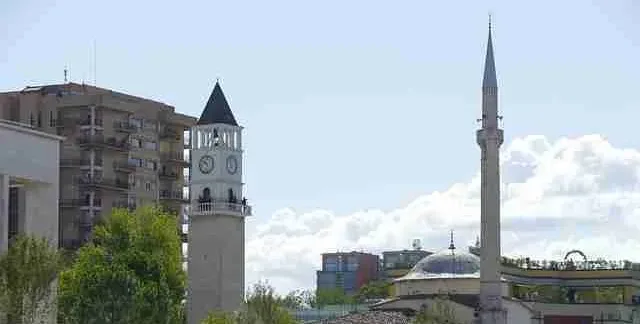Tirana

Albania - What to see in Tirana
Highlights of Tirana in Albania
Tirana in Albania, the country’s capital and largest city, offers a vibrant mix of history, creativity, and modern energy. Nestled in a valley surrounded by mountains, Tirana blends Ottoman-era architecture, Communist-era landmarks, and contemporary design. From bustling squares to peaceful parks, the city invites visitors to explore its many layers.
Despite its growth and development, Tirana retains a welcoming atmosphere. Locals are known for their warmth, and the city’s compact layout makes it easy to navigate. Whether you’re interested in historical sites, cultural experiences, or lively nightlife, Tirana provides something for every kind of traveller.
Skanderbeg Square and its Surroundings
At the heart of Tirana lies Skanderbeg Square, a central gathering place named after Albania’s national hero, Gjergj Kastrioti Skanderbeg. His equestrian statue stands proudly in the middle of the square, surrounded by fountains, flowerbeds, and open space.
On the north side, the National History Museum offers a comprehensive look at Albania’s past. Its exhibits include archaeological finds, cultural artefacts, and stories from different eras. The museum’s mosaic façade is one of the city’s most recognisable features.
Nearby, the Et'hem Bey Mosque showcases Ottoman architecture with detailed frescoes and a peaceful courtyard. Adjacent to the mosque, the Clock Tower rises 35 metres and provides panoramic views of the city. Visitors can climb to the top for a unique perspective on Tirana’s layout.
Also close by, the National Opera and Ballet Theatre hosts performances throughout the year. From classical music to contemporary dance, the venue reflects Tirana’s growing cultural scene.
Exploring Tirana’s Historical Sites
One of the city’s most compelling attractions is BUNK’ART 2, a museum housed in a former nuclear bunker. It explores Albania’s Communist period, offering insight into the regime’s rise and fall. Through interactive displays, video installations, and personal testimonies, the museum presents a powerful narrative of resilience and change.
In addition, Tirana Castle provides a glimpse into the city’s medieval past. Though much of the original structure has been integrated into modern buildings, parts of the walls remain, and the area now features cafés and artisan shops.
The House of Leaves Museum, once the headquarters of the secret police, now documents Albania’s human rights history. Its exhibits focus on surveillance, resistance, and the impact of authoritarian rule.
Art lovers will appreciate the National Gallery of Arts, which displays works from the 19th century to the present. The collection includes paintings, sculptures, and installations by Albanian artists, offering insight into the country’s creative evolution.
Culture and Nightlife in Tirana
Tirana in Albania is known for its dynamic cultural life. The city hosts a variety of museums, galleries, and theatres, as well as independent cinemas and music venues. Events and festivals take place throughout the year, celebrating everything from film and literature to food and fashion.
As evening falls, Tirana’s nightlife comes alive. The Blloku district, once restricted to government officials, now buzzes with cafés, bars, and clubs. Whether you’re looking for a quiet drink or a lively dance floor, you’ll find plenty of options.
Live music is common, with venues offering jazz, rock, and traditional Albanian sounds. Many places also serve local wines and craft beers, adding a regional flavour to the experience.
More Things to Do in Tirana
Beyond the main attractions, Tirana offers many ways to enjoy its atmosphere and surroundings.
Visit the New Bazaar
The New Bazaar (Pazari i Ri) is a lively market where you can shop for fresh produce, handmade crafts, and souvenirs. Renovated in recent years, the area combines traditional charm with modern design. It’s a great place to sample local food and interact with vendors.
Walk Through the Grand Park
Tirana’s Grand Park (Parku i Madh) provides a peaceful escape from the city’s bustle. The park features gardens, fountains, and monuments, as well as a large artificial lake. Locals come here to walk, jog, or relax under the trees. It’s also home to the Presidential Palace and several cultural institutions.
Ride the Dajti Ekspres Cable Car
For stunning views, take the Dajti Ekspres cable car to the top of Dajti Mountain. The ride offers a scenic journey over forests and hills, and the summit provides panoramic views of Tirana and the surrounding region. Restaurants and hiking trails make it a popular spot for day trips.
Explore Nearby Towns
Tirana’s location makes it a convenient base for exploring other parts of Albania. Day trips to historical towns such as Kruja, Berat, and Gjirokastra reveal more about the country’s heritage. Each town features unique architecture, museums, and local traditions.
Practical Tips for Visiting Tirana
To make your visit smooth and enjoyable, keep these tips in mind:
- Best Time to Visit: Spring and autumn offer pleasant weather and fewer crowds. Summers can be hot, while winters are mild but wetter.
- Currency: The Albanian Lek (ALL) is the local currency. Credit cards are accepted in many places, but cash is useful for markets and small shops.
- Language: Albanian is the official language, but English is widely spoken in tourist areas. Many signs and menus are bilingual.
- Transport: Tirana is walkable, but taxis and buses are available. Rideshare apps also operate in the city. For trips outside Tirana, consider renting a car.
- Safety: Tirana is generally safe, with low crime rates. As always, stay aware of your surroundings and keep valuables secure.
So should I visit Tirana in Albania?
Tirana in Albania is a city full of surprises. Its mix of historical depth, artistic expression, and modern energy creates a welcoming and engaging atmosphere. Whether you’re exploring museums, enjoying local cuisine, or relaxing in a park, Tirana offers a memorable experience.
The city’s charm lies in its contrasts between old and new, quiet and lively, traditional and contemporary. Visitors often leave with a deeper appreciation for Albania’s culture and a desire to return.
